Explore Top Skim Boards: Ultimate Buying Guide
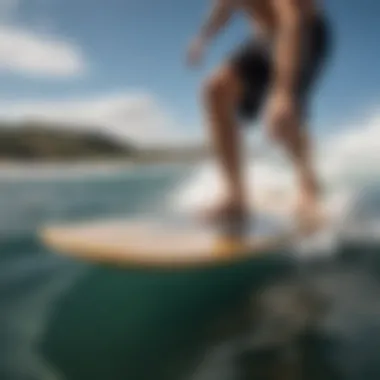
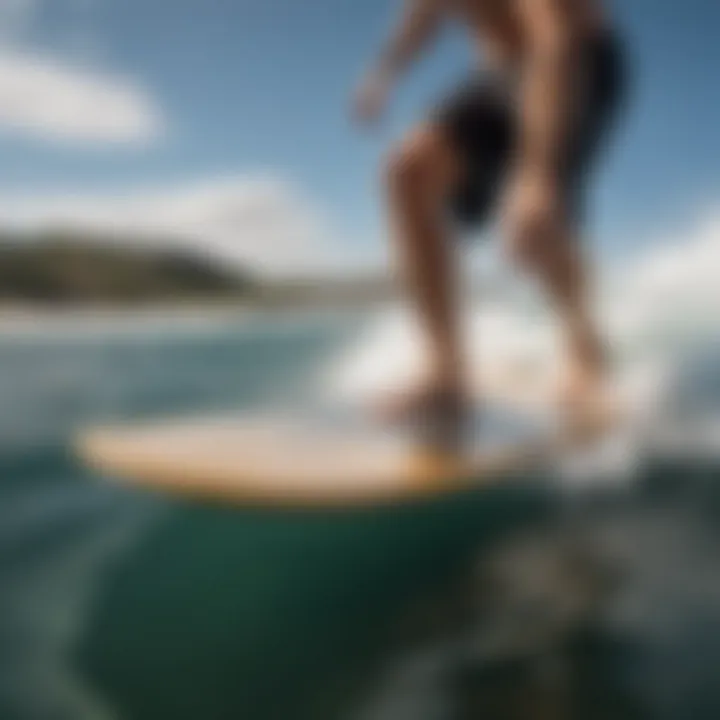
Intro
The thrill of gliding across the surface of the water is an experience like no other. Skimboarding invites enthusiasts to harness the power of the waves while showcasing their skills on the beach. Whether you’re a seasoned pro or just starting, finding the right skim board can significantly enhance your riding experience. In this guide, we will dive deep into the world of skim boards, unraveling the key features, materials, and technology behind some of the top models in the market.
Our focus is to equip surfers, instructors, beach lifeguards, outdoor writers, and even marine biologists with a rounded understanding of this dynamic sport. Every detail matters—be it maintenance tips for prolonging the life of your board or exploring different riding styles suited for diverse skill levels.
By the end of our discussion, you’ll have gained valuable insights to select the perfect skim board, elevate your techniques, and embrace sustainable practices in the sport. So, let’s ride the wave and jump right in!
Prelude to Skimboarding
Skimboarding, often overshadowed by its more prominent cousin surfing, has nestled its way into beach culture with a unique charm and thrill. This guide aims to shed light on the multifaceted world of skimboarding, detailing its essence and relevance for enthusiasts, novices, and professionals alike.
What is Skimboarding?
In a nutshell, skimboarding can be described as riding a small, flat board on wet sand or shallow water. Before the waves crash against the shore, skimboarders toss their boards onto the thin layer of water left by receding waves and hop on, gaining speed as they glide along. More than just a pastime, it blends elements of balance, coordination, and timing, making it a demanding yet incredibly rewarding activity. It’s not just about getting from point A to B; it’s about mastering the art of flow and motion across the surface of the water.
History of Skimboarding
The roots of skimboarding stretch back to the 1920s in Laguna Beach, California, where it evolved from a practical necessity into a thrilling sport. Initially, locals used wooden boards to glide along the shore's wet sand, helping surfers to catch waves more efficiently. Over the decades, skimboarding has transformed tremendously, with advancements in technology and materials crafting boards that push the sport into new realms of performance and style. From the humble beginnings on local beaches to competitive events and dedicated communities around the globe, skimboarding has secured its place as a vibrant niche within the water sports scene.
Why Choose Skimboarding?
Choosing skimboarding over other water sports can seem like a curious decision at first, yet the reasons to dive into this activity are manifold:
- Accessibility: With just a skimboard and a sandy beach, you’re ready to roll. There’s no need for waves or complex setups, making it easier to enjoy any time you hit the shore.
- Physical Fitness: This sport is a full-body workout that can improve balance, agility, and strength. While primarily a lower body activity, completing tricks and maneuvers also engages your core and arms.
- Community Spirit: The skimboarding scene is inviting and supportive. Whether you're a breeze-on-by beginner or a seasoned pro, the camaraderie among skimboarders creates a sense of belonging.
"Skimboarding isn't just a sport; it's a lifestyle that stems from the sun, sea, and sand. It's about sharing experiences and pushing each other to new heights."
Ultimately, skimboarding offers not only thrilling adventures but also a pathway to personal growth and connection with others who share similar passions. As we delve deeper into the specifics of this sport and the equipment used, the goal is to enlighten you on how to navigate this dynamic domain with finesse.
Understanding Skimboards
In this part of the guide, we focus on Understanding Skimboards, a foundational aspect that is often underestimated by newcomers and even some seasoned riders. Knowing the types, materials, and design features of skimboards is crucial. This isn’t just about picking any board that catches your eye on the rack. The right choice can significantly enhance your experience, performance, and safety.
Different Types of Skimboards
Skimboards come in a variety of styles, each tailored for specific conditions and riding preferences. Let’s break down the main types:
Standard Skimboards
Standard skimboards are great for those just starting out or looking for a versatile option. They are typically made of sturdy materials and provide a balance between durability and performance. A key characteristic is their wide surface area, which helps with stability when riding on the water and land.
The unique feature here is the overall versatility. They work well in various conditions, making them a popular choice for families and beginners. However, they might not offer the same high-speed performance as other more specialized boards, making them less appealing for advanced tricks.
Performance Skimboards
Performance skimboards shine when it comes to speed and agility. These boards are lighter and usually made from high-tech materials like epoxy or carbon fiber. They often feature a sleek design that cuts through the water, minimizing drag.
The standout characteristic here is how they enhance maneuverability, allowing for sharper turns and quicker reactions. This type is a favorite among experienced skimboarders who delve into competitions and advanced tricks. The downside? The thin design can lead to a less forgiving experience on rougher surfaces, which might not suit those still honing their skills.
Sand Skimboards
Sand skimboards are designed specifically for the beach environment, making them ideal for riding on wet sand. Their wider, flatter shapes allow for maximum surface area contact, which enhances balance.
The main benefit of sand skimboards is their broad utility on sandy shores. Riders can glide smoothly without sinking too deep into the softer surface. However, they can be less effective on hard-packed surfaces or water compared to their performance counterparts, so riders need to be aware of the environment where they plan to use them.
Skimboard Materials
The materials used in making skimboards significantly influence their performance and longevity. A deeper dive into the various materials can help you decide what’s best suited for your needs.
Polyester
Polyester is a common material used in making skimboards, primarily due to its cost-effectiveness and durability. Boards made from polyester are resilient and can withstand various weather conditions, making them quite reliable.
A defining characteristic is its solid rigidity, which keeps the board stable during rides. However, while they are durable, they may not perform as well in terms of flexibility and weight compared to other materials.
Epoxy
Epoxy boards are known for being lightweight and incredibly strong. They provide excellent buoyancy which can enhance your performance on water, translating to quick speeds and dynamic maneuvers.
The unique factor here is their resilience in impact. An epoxy skimboard can take a beating without significant wear. The trade-off may be related to price, as they tend to be more expensive than polyester boards, making them an investment for serious riders.
Wood
Wooden skimboards have an old-school charm, favored by many for their natural aesthetic. They are generally heavier but can provide a unique feel when riding. One of the defining features of wooden boards is their ability to absorb shocks, making them great for beginners learning how to balance.
However, they are prone to water damage unless properly treated, and may not perform as well when compared to synthetic materials in competitive scenarios.
Design Features of Skimboards
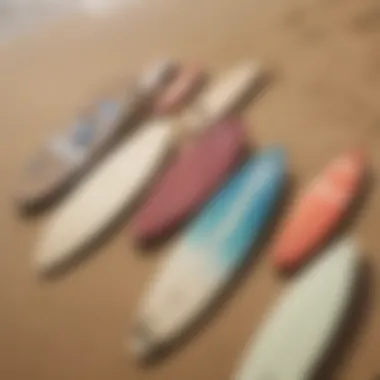
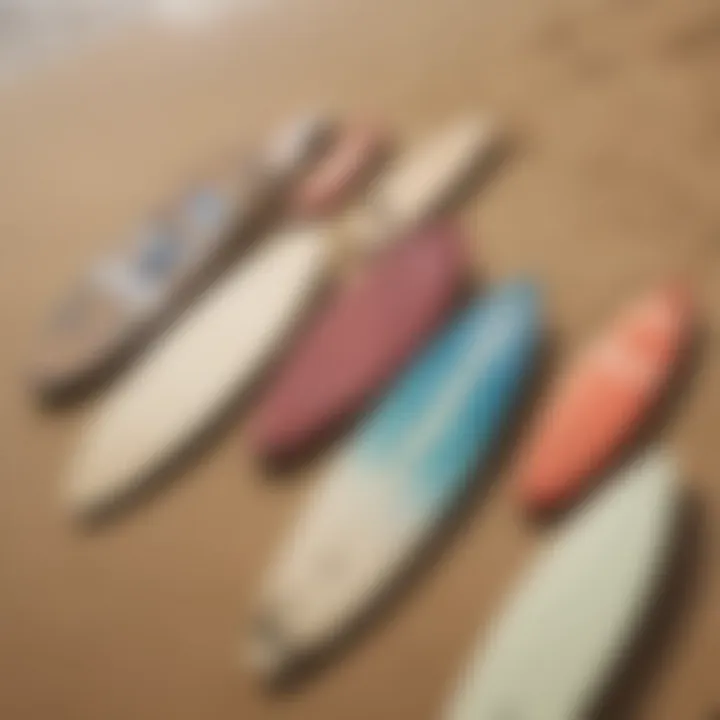
Design plays a large role in how well a skimboard performs. Various features can drastically affect your riding experience.
Board Shape
The shape of the board can influence speed and stability. Wider boards offer more balance but might reduce maneuverability. Conversely, slimmer boards can slice through the water beautifully but require more skill to stay upright.
A notable mention is the crescent-shaped boards, which allow for tricks and sharp turns but may not be best for beginners.
Thickness
Thickness impacts a board’s buoyancy and flexibility. Thicker boards can support more weight and provide stability, while thinner boards can deliver improved speed. Knowing your comfort level and skill will guide your choice here.
Tail Design
The tail of the board also has implications for performance. A square tail offers great stability, particularly beneficial on flatter surfaces, while a pointed tail can enhance speed and control during sharp turns.
Criteria for Selecting the Best Skim Board
Choosing a skim board might seem straightforward, but it's more akin to picking a partner for a thrilling dance on the shore. It’s essential to consider several factors that will influence your experience and performance on the water. Each person's needs, whether beginner or seasoned rider, shape how they interact with the waves and what will work best for them. In this section, we’ll explore key criteria that you must ponder over to select the best skim board, focusing on skill levels, weight capacities, and riding preferences.
Skill Level Considerations
When stepping into the world of skimboarding, recognizing your skill level is pivotal. Beginners, for instance, would benefit from a board that offers stability and ease of control. A wider and thicker board generally provides a steadier ride, making it simpler to balance and maneuver.
Conversely, if you have more experience under your belt, performance boards tailored for tricks or speed could be your jam. These boards are often thinner and lightweight, permitting better agility on the waves. The importance of choosing the right tool for your proficiency cannot be overstated. If a novice selects an advanced board, frustration can easily replace the fun. Likewise, advanced skimboarders should steer clear of overly accommodating boards that might hinder their tricks or speed potential.
Weight Capacity of Skimboards
Next up, let’s hash out weight capacity. Every skimboard can handle a specific weight range, and riding a board beyond its limit is a recipe for disaster. It’s not just about personal comfort; overloading a board can lead to instability, reducing performance efficiency.
For example, the maximum weight a board can support usually fluctuates based on its materials and design. If you’re an adult skimboarder weighing around 200 pounds, a board designed specifically for heavier riders will provide the robustness you need, preventing unwanted flex or breakage. It's wise to check the manufacturer's recommendations; many brands may even provide a clear weight range on their packaging or website.
Riding Style Preferences
Finally, let’s dive into riding style preferences. Just as every surfer has a unique approach to riding the wave, skimboarders can have varied styles, from casual cruising to aggressive tricks. Knowing what kind of riding you enjoy most will help narrow down your options.
For those who prefer a laid-back ride, broader boards with plenty of surface area are favorable. They provide solid grip when gliding across the sand. Alternatively, if you lean toward adventurous stunts, narrower performance boards that excel in speed and agility would suit you better.
An effective method to ease this decision is to take note of your riding style during practice. Observing how you react on the water with your current board can offer profound insights as to what aspects you would like to enhance or refine.
"Selecting the right skim board is not just about purchasing; it’s about enhancing your entire skimboarding experience. Each criterion plays a part in ensuring your enjoyment and safety on the water."
Just as the ocean varies with tides, so too should your consideration of these factors when selecting your skim board. By being mindful of your skill level, weight requirements, and preferred style, you ensure your connection with the water remains thrilling and enjoyable.
Top Skim Boards on the Market
When diving into the world of skimboarding, the top skim boards on the market hold crucial significance. They are not just tools for riding the waves or gliding across the shore; they represent the intersection of innovation, performance, and individual style. Choosing the right skim board can drastically affect a rider’s experience, making it essential to know which boards excel in specific criteria. For beginner riders or seasoned experts alike, recognizing these elements provides both guidance and confidence in selecting the perfect board.
Performance Skimboards
Performance skimboards are designed for those who seek speed, flexibility, and advanced tricks. Typically, these boards are thinner with a more aggressive shape, allowing for greater maneuverability. Riders looking to pull off flips or navigate tight curves favor performance boards. Often made from durable materials like epoxy and featuring advanced tail designs, these skimboards maximize responsiveness.
In terms of advantages, many performance skimboards have the following traits:
- Lightweight Construction: Easier for tricks and maneuvers.
- Enhanced Glide: Higher speeds on the water.
- Precision Control: Critical for skilled riders.
These boards can often come with a steeper price tag, but for many enthusiasts, they are worth the investment. High performance translates to more thrilling rides and a greater sense of accomplishment.
Best Value Options
Not everyone is ready to break the bank for a skimboard, and that's where the best value options step in. These boards manage to strike a balance between quality and cost-effectiveness. They cater to casual riders and those starting out, without sacrificing the essential features that make skimboarding enjoyable.
Key aspects of best value options include:
- Solid Build: Often made of good materials like polyester or wood, ensuring longevity.
- Ease of Use: Typically user-friendly for beginners.
- Affordability: Allowing more people to get into the sport without heavy financial investment.
For beginners or those who skimboard occasionally, these options represent an opportunity to enjoy the sport without committing to high-end prices. They perform adequately in various surf conditions and allow users to grow into their skills over time.
Innovative Features in Current Models
In recent years, technology and design trends have pushed forward the capabilities of skimboards. New models come packed with innovative features that help riders enhance their skills and experience.
Some noteworthy innovations are:
- Hydrodynamic Shapes: Boards are designed to cut through the water more smoothly.
- Flex Technology: Advanced materials allow for improved flexibility without sacrificing durability.
- Non-Slip Surfaces: Enhancing control while riding and preventing slips during tricks.
These advancements cater to both performance-driven riders and those just starting. As the market evolves, keeping an eye on these innovative features can significantly improve one’s skimboarding journey.
"Investing in the right board can make all the difference between an enjoyable day at the beach and a frustrating experience."
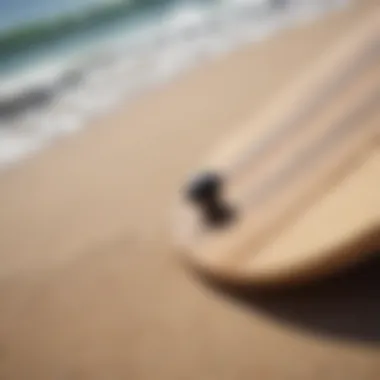
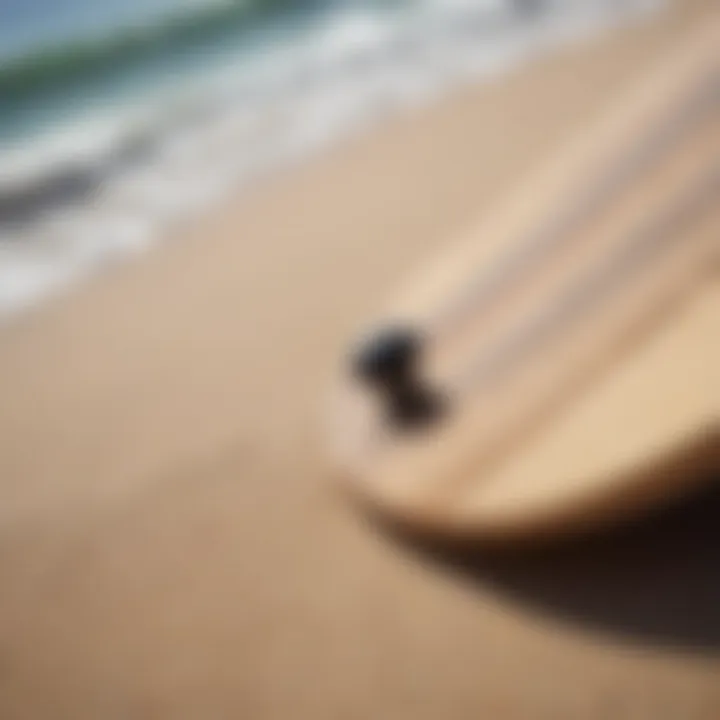
As the market continues to evolve, identifying top skimboards provides a solid starting point for any individual looking to enjoy what this aquatic sport has to offer.
Maintaining Your Skim Board
Taking good care of your skimboard is just as vital as picking the right one. Maintenance can extend the life of your board and optimize your performance on the water. Like a trusty compass for a sailor, a well-maintained skimboard helps you navigate the waves with confidence and finesse. It's not just about aesthetics; it's also a matter of safety and functionality. After all, a neglected board might turn into a safety hazard, making it harder to ride or even causing injuries.
Cleaning and Care
Regular cleaning is simple yet super important. After every session on the beach, rinse off your skimboard with fresh water to get rid of sand, salt, and debris. Salt can be like a silent killer, corroding the board over time, so don't let it stick around. Use a soft cloth or sponge to wipe the surface gently.
Here are a few tips to keep your board shining:
- Freshwater Rinse: Always start with a freshwater rinse after each use.
- Mild Soap: If you've been through some serious mucky water, a mild soap mixed with water works wonders.
- Dry Thoroughly: Never leave it damp; this can lead to mold and an unpleasant smell.
Remember, you want your board to look great and perform even better. Regular care will help maintain its integrity, keeping you gliding smoothly over those waves.
Repairing Damage
Even the best skimboards can take a beating. Scrapes from a rocky shoreline or dings from a wayward branch can hinder your performance. Knowing basic repair techniques can save you from an early retirement of your favorite board.
Follow these steps for minor repairs:
- Inspect the Damage: Identify cracks, dents, or delaminations on your board.
- Use Epoxy Resin: For little cracks, apply a bit of epoxy resin according to the manufacturer's instructions. This seals the damage nicely.
- Sand Smooth: Once the resin cures, lightly sand the area until it’s smooth.
- Repaint if Needed: If aesthetics are a concern, consider repainting to match the original color of your board.
Keeping a well-stocked repair kit nearby is a great practice. Without proper attention, a small issue could transform into an expensive repair down the line.
Storage Tips
Storing your skimboard correctly can make a world of difference in its longevity. Leaving it in the sun or crammed in a tight space might warp its shape. Instead, aim for a cool, dry place away from direct sunlight.
Here are some effective storage strategies:
- Vertical Storage: Store your board upright if possible, to prevent warping.
- Avoiding Heavy Loads: Don’t stack heavy items on top of it, as this can flatten the board over time.
- Use a Board Bag: Consider investing in a padded board bag; it adds a layer of protection from scratches and bumps when transporting.
The more mindful you are about storage, the longer your skimboard will serve you well. A little care goes a long way in keeping your investment safe and sound.
Remember: A well-maintained skimboard isn't just for show; it's your trusty partner on the waves. Treat it right, and it will reward you!
In summary, taking time to clean, repair, and store your skimboard correctly ensures you’ll have a smoother ride, prolonging its life while enhancing your performance. This level of consideration allows you to focus on what truly matters: enjoying the ocean and mastering your skills.
Learning How to Skimboard
The realm of skimboarding is not just about the boards or the waves; it's about mastering a skill that brings together balance, agility, and a touch of creativity. Learning how to skimboard can seem daunting for newcomers, but this activity not only provides a unique connection with the ocean but also nurtures physical fitness and mental resilience. As with any sport, turning skills into second nature is key, and that’s what this section aims to cover. By diving into the core techniques, advanced maneuvers, and safety practices, readers can equip themselves with a robust understanding to enhance their skimboarding experience.
Fundamental Techniques
To kick things off, let’s talk about the fundamental techniques of skimboarding. These are the building blocks; get these right, and the rest will follow suit. Here are a few core techniques to focus on:
- Run and Drop: Start by gaining momentum with a quick jog towards the water. As you reach the edge, drop your board onto the wave with a swift motion. The key is to time this precisely; too early, and the board won't skim; too late, and you risk a wipeout.
- Balance: Once you're on the board, staying balanced is crucial. Bend your knees, keep your center of gravity lowered, and use your arms for balance. Think of it as riding a bicycle; you don’t need to think much about pedaling as long as you maintain equilibrium.
- Turning: After a few successful drops, practice turning. Shift your weight gently to your toes or heels depending on the curve you want to take. This adds an exciting element to your ride and helps build confidence.
At the crux of these fundamentals lies persistence. It’s not uncommon to fall a few times, but getting back up and trying again is what makes a true skimboarder.
Advanced Tricks and Maneuvers
Once you’ve soaked in the basics and find yourself comfortable on the board, it’s time to push the limits with some advanced tricks and maneuvers. These tricks not only impress onlookers but also challenge your skills:
- Barrel Roll: This trick is a cornerstone of advanced skimboarding. Start with a good speed, then lean into a sharp turn while maintaining forward momentum—this creates a rolling motion, and you’ll soon find yourself completing a full rotation.
- 180 Spins: The thrill of spinning in mid-air can be euphoric. To execute a 180 spin, approach the water at a slight angle, then rapidly shift your body weight and twist your lower body, allowing the board to rotate beneath you. Timing and practice will refine your execution.
- The Big Drop: For the more daring, practicing drops off higher banks can lead to unforgettable moments. Make sure you have solid landing techniques in your arsenal. A wrong move here can lead to a tumble.
- Combo Moves: Combine any two or more maneuvers seamlessly. This is where creativity shines in skimboarding. The more you mix and match, the more impressive your performance will become.
Safety Practices for Skimboarding
While chasing the thrill of skimboarding, safety should never take a back seat. Engaging in this sport comes with its fair share of risks, but with proper safety practices, one can mitigate many of them:
- Wear Appropriate Gear: A good pair of water shoes can protect your feet, while a wetsuit can help if the water is chilly. For beginners, a helmet could be wise since falls are common.
- Know the Environment: Before hitting the waves, take time to survey the beach. Look for hazards like rocks or strong currents. Pay attention to tide patterns; some areas can get tricky, depending on the phase of the tide.
- Start Small: Don’t jump into trickier maneuvers without getting comfortable on the board first. It's better to build your skill over time rather than risk injury for the sake of coolness.
By approaching skimboarding with respect and caution, you ensure that your experience is not only enjoyable but also safe.
"Safety isn’t just a precaution; it’s a pathway to enjoyment and longevity in any sport."
In summary, learning how to skimboard interweaves technique, creativity, and safety. With dedication to honing fundamental skills, trying out advanced tricks, and applying sound safety practices, enthusiasts can truly embrace the dynamic world of skimboarding, building confidence and competence in this rewarding lifestyle.
Environmental Impact of Skimboarding
Understanding the environmental repercussions of skimboarding is essential in our journey towards a more responsible outdoor lifestyle. This part of the article underscores why it’s pivotal to address the environmental implications associated with the sport, considering the materials used, the ecosystems we're interacting with, and our broader role in preserving nature while enjoying its offerings. As the skimboarding community grows, so does the responsibility to ensure its sustainability and harmony with the environment.
Sustainable Skimboarding Materials
When it come to skimboarding, the materials chosen have a significant sway on environmental footprint. Traditional materials like fiberglass and resin might be durable but often harm the earth during production and disposal. Thankfully, there are increasingly sustainable alternatives emerging that riders can consider.
- Bamboo: Lightweight and strong, bamboo has rapid growth cycles making it a renewable choice. Its use can substantially lower the carbon footprint of production.
- Recycled materials: Some manufacturers are taking strides to utilize recycled plastics and other materials to create eco-friendly boards. This not only reduces waste but helps in cutting down on new resource extraction.
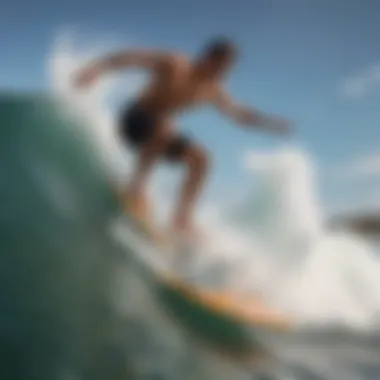
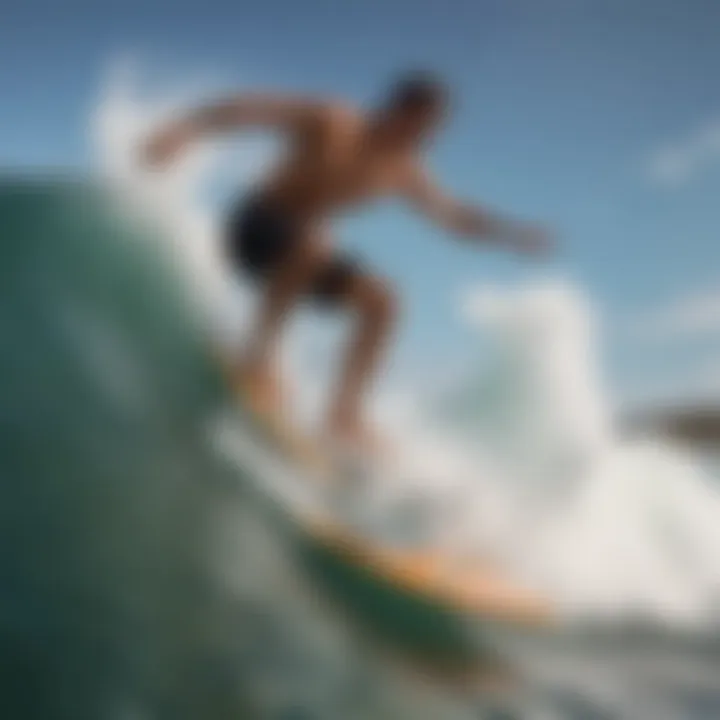
Investing in boards made from such sustainable materials isn’t just good for the planet; it's also a statement of health and stewardship in our community. By opting for these options, we actively participate in nurturing the beaches and landscapes we love.
Conservation Volunteering Opportunities
Another path to contributing positively to the environment is by engaging in conservation efforts. There are several volunteering opportunities tailored for those passionate about keeping our waterways and beaches clean. Joining local beach clean-ups or environmental awareness campaigns can significantly impact.
Most coastal areas often have groups that organize activities aimed at preserving marine habitats. Participating in these endeavors not only beautifies the beach but enriches your connection with the land and water. For instance:
- Beach clean-up drives: Local organizations frequently mobilize volunteers to gather debris from shorelines, preventing pollution.
- Marine biology events: Some programs offer chances to learn about local ecosystems while contributing to research or restoration projects.
These opportunities foster a sense of community, unity, and shared responsibility that transcends skimboarding itself.
Promoting Responsible Practices
Promoting responsible practices within the skimboarding community is crucial as enthusiasts from diverse backgrounds come together. It’s more than just respecting personal riding spaces; it’s an understanding of collective responsibility. Here are key practices to consider:
- Choose the right spots: Opt for skimboarding locations that are designated for such activities, preserving fragile ecosystems.
- Educate others: Share information about how to maintain a clean environment. Reminding newcomers and seasoned skimboarders alike of their impact can create a wave of change.
- Avoid wildlife disturbances: Respect habitats and wildlife in your vicinity. Keeping a safe distance when encountering marine life ensures their safety and health.
Being a responsible skimboarder fosters an environment where everyone can enjoy the sport while respecting our surroundings. A conscientious approach both uplifts the community and ensures sustained enjoyment for future generations.
Remember, every small action can ripple through the community and contribute to a healthier planet, one skimboard at a time.
Connecting with the Skimboarding Community
Connecting with the skimboarding community is crucial for enthusiasts at any level. Engaging with like-minded individuals can provide not just camaraderie but also invaluable insights, encouragement, and tips that can help one improve their skills. Being part of this community fosters a sense of belonging and shared passion, making the sport more enjoyable and rewarding. Participating in club activities, events, and online discussions can also open doors to learning opportunities, where experienced riders can offer guidance and newcomers can ask questions in a supportive environment.
Finding Local Skimboarding Clubs
Finding local skimboarding clubs is one of the simplest ways to dive into the community. Many coastal areas have dedicated groups that meet regularly, either at the beach or community centers. These clubs often cater to various skill levels, so whether you're just starting out or are a seasoned player looking to refine your techniques, you’ll likely find a group that fits your needs.
Benefits of Joining Local Clubs:
- Skill Development: Members often share techniques and advice, which can help improve your form.
- Equipment Sharing: Clubs sometimes have boards available for practice, reducing the cost for newcomers.
- Networking Opportunities: Make connections with other skimmers who can join you for casual rides or train with you.
You can check local directories, social media pages, or websites dedicated to water sports for information about these clubs. Don't hesitate to introduce yourself; most members are welcoming and will be eager to help you get started.
Participating in Events and Competitions
Taking part in events and competitions can elevate your skills and provide thrilling experiences. Ranging from local meets to international competitions, these events often attract skimmers of all ages and backgrounds. In addition to the thrill of competition, these gatherings foster a spirit of friendship and sportsmanship, as everyone shares a common love for the sport.
Considerations before Entering Competitions:
- Know Your Level: Start with a competition that matches your skill to avoid unnecessary pressure.
- Understand the Rules: Familiarize yourself with the event's specific rules and format, as they can vary significantly.
- Focus on Fun: Winning is great, but the aim should primarily be to enjoy the experience and learn from others.
Competitions also provide exposure. You may meet sponsors or coaches interested in helping you take your skills higher. Plus, competing allows you to see different styles of skimboarding, potentially influencing your own technique and approach.
Online Forums and Resources
In today's digital age, online forums have become a cornerstone of the skimboarding community. Websites like Reddit have dedicated threads where skimboarders share experiences, tips, and even gear for sale or trade. Participating in these platforms can be especially beneficial for those who may not have local clubs nearby.
Popular Online Platforms for Skimboard Enthusiasts:
- Reddit: Explore communities focusing on skimboarding where users share photos, videos, and advice.
- Facebook Groups: Many local clubs or enthusiastic groups post updates, organize events, and share learning resources.
- YouTube Channels: Various channels offer tutorials and tricks that can enhance your riding skills.
Engaging in these forums not only helps you stay updated on the latest trends but also provides an opportunity to connect with skimmers from different parts of the world. You’ll likely find videos of unique spots or innovative techniques that can challenge you and broaden your understanding of the sport.
"Joining the skimboarding community is about more than just the sport; it’s about creating bonds and sharing adventures that last a lifetime."
In summary, becoming involved with the skimboarding community not only enhances your skills but enriches your overall enjoyment of the sport. Whether you find a local club, participate in competitions, or connect through online forums, the connections made can lead to profound personal growth and immense fun.
Epilogue
The conclusion of this extensive guide serves as an endorsement of the important insights gathered throughout the article. Stemming from the exploration of materials, riding styles, and community connections, the core of skimboarding lies not just in choosing the right board but in understanding the broader implications of one's engagement with this unique sport.
In sum, when selecting a skimboard, one must consider a variety of factors, including skill level, board type, and personal preferences. Knowing how to maintain your equipment properly enhances longevity, and sustains performance, ultimately leading to more enjoyable experiences out on the beach.
"Your skimboard is not just a piece of equipment; it reflects your commitment to the ocean and lifestyle it embraces."
Recap of Key Considerations
As we draw to a close, it’s worth highlighting several important aspects:
- Types of Boards: Each skimboard has its strengths based on the environment and the rider's skill. Standard boards are good for beginners, while performance boards offer advanced users a chance to push boundaries.
- Material Choices: Polyester, epoxy, and wood each come with their pros and cons. Understanding these will aid in making an informed decision.
- Skill Development: Starting with the fundamentals and gradually moving towards advanced maneuvers is essential. Learning the right techniques not only boosts your confidence but also your proficiency.
- Environmental Responsibility: Skimboarding should be enjoyed with awareness towards our environment. Choose sustainable products and practice responsible sportsmanship.
Ultimately, these considerations contribute to a more fulfilling journey in the world of skimboarding.
Encouragement for Continuous Learning and Exploration
The degradation of the beach or waterways serves as an unfortunate reminder that nature is not invincible; it's our job to care for it. Skimboarding is more than just a sport; it’s a lifestyle intertwined with the elements. Embracing this journey means continuously learning.
Seek out new techniques, attend workshops, join clubs, and participate in local events. Not just to sharpen your skills, but also to forge connections within the skimboarding community that can enrich your experience.
Moreover, resources like Reddit and various Facebook groups provide fantastic platforms for knowledge sharing. Discover tips from fellow riders around the globe. Make it a habit to seek out books, videos, tutorials, or even consider environmental avenues to understand better the impact of sports like skimboarding.
By fostering an attitude of curiosity and dedication, you not only improve your skills but also gain deeper respect for the sport, the ocean, and the community surrounding it.















